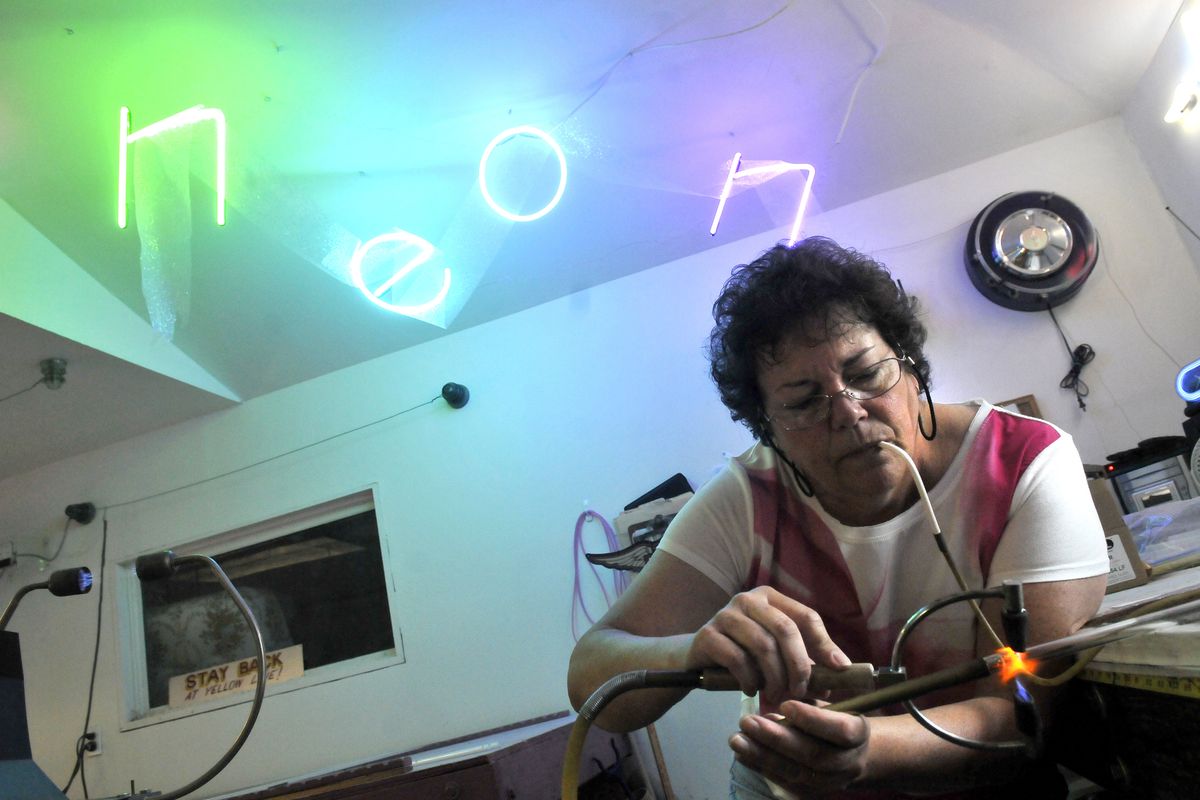Dana Eberly has plied glass tubes into glowing neon signs since the ’80s

In the 1930s and ’40s, neon lights screamed exciting night life, beckoning customers to bars, late-night coffee shops and dance halls. In the years following, the signs fell out of favor.
The lights made a comeback in the 1980s. Artists made freestanding neon sculptures and fashion adopted its bright colors.
Spokane Valley resident Dana Eberly, 59, was in New York with her husband, Vinton Eberly, while he was working in post-production special effects for the movie, “9 to 5,” in 1980.
While they were there, they went to a neon art exhibition at Let There Be Neon, a gallery and studio. The art form was in the early stages of making its comeback.
When the two moved to Seattle, as a gift, her husband enrolled her in an art course in Seattle specializing in creating neon signs and sculptures.
“It’s his fault,” Dana Eberly joked.
For the past 17 years, she’s had a shop in her garage, specializing in sign repair and original signs, mostly wholesale work. She just makes the signs, she’s not licensed to install them.
Over the years, she’s helped to repair the neon waving pilot at Felt’s Field. She made the sign for the former Globe restaurant on Division Street, the sign at Hill’s Restaurant downtown and repaired the clock at Dodson’s Jewelers.
“I’ve repaired just about everything in Spokane,” she said.
She’s grown tough fingers over her career. She said she has cut or burned every single finger and her kids often joke that “Mom doesn’t need potholders.”
To make a sign, Eberly has several propane burners, which heat up to 1,200 degrees. She plugs one end of a glass tube which has been coated with phosphorous on the inside and a blow hose on the other end.
While she heated the tube, Vinton Eberly explained that she blows into the tube to maintain the air pressure, since when it bends it could fold into itself. The blow hose ensures smooth curves and bends.
“The hardest thing to learn is the curves,” Dana Eberly said.
It takes only a couple of minutes for the glass to become pliable. When that happens, Eberly moves the glass tube away from the burner and flicks her wrists, creating a spiral in the glass.
“It’s all freehand,” she said.
Different noble gases create different colors. Red signs are neon. Any color other than red is made using an argon mix. The gas is the light source. Electricity arcs from an electrode at one end of the tube through the gas to another electrode.
After the glass is bent, Dana attaches electrodes to either end of the tube using a hand-held gas burner. She then uses a vacuum pump to remove the air from the tube. The processing also heats the glass to clean the inside of any impurities and activate the coating on the inside and she releases the gas into the tube. The temperature of the glass must reach 451 degrees. To know when the glass is hot enough, she lays a piece of paper on the tube. When the paper chars, the processing is done.
She can play with the light after the processing if she wants to. She has a transformer which can make the gas look like it is moving in the tube – an effect she calls a jelly bean.
Eberly knows many neon artists, but her favorite thing about working in neon signs is restoring old signs. In her backyard, she has an enormous red and white tin cow that reads, “George’s Famous Steaks.” There are holes in the tin where the neon should go.
She’s likes to think about the people who made the signs originally while she works on the signs. She looks at the bend in the glass and thinks about the craftsmanship.
“There’s so much to do,” she said. “There are many broken beer signs.”
As an industry, the sign business is switching to LED, but Eberly feels like she’ll have enough work to keep her busy for many years to come.
“As an art form, I think neon will always be here,” she said.